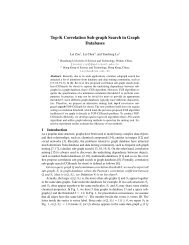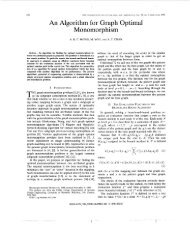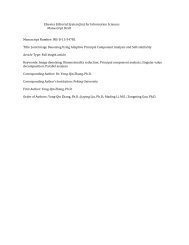PDF (1MB) - QUT ePrints
PDF (1MB) - QUT ePrints
PDF (1MB) - QUT ePrints
Create successful ePaper yourself
Turn your PDF publications into a flip-book with our unique Google optimized e-Paper software.
4 · Alsayed Algergawy et al.<br />
features similarity. Clustering the XML documents by considering the structural and content<br />
features together will result in three clusters, namely “Books on Data Mining (DM)”,<br />
“Books on Biology (Bio)” and “Conference articles on Data Mining”.<br />
In order to conduct a good survey and to construct a fair base for comparing existing<br />
XML data clustering approaches, a high-level architecture for a generic framework of<br />
XML data clustering is proposed. Inspired from data clustering activity steps [Jain et al.<br />
1999], Fig. 2 depicts the framework of XML data clustering with three basic phases.<br />
(1) Data representation. XML data are represented using a common data model that<br />
captures semantic and structure information inherent in XML data. This phase includes<br />
two subphases that are feature selection and feature extraction. Feature selection<br />
chooses distinctive features from a set of candidates, while feature extraction<br />
employs rules to generate useful and novel features from the original ones. We elaborate<br />
on XML data representation in Section 3.<br />
(2) Similarity computation. The proximity functions to measure the similarity between<br />
pairs of data objects are determined. XML data are grouped according to the similarity<br />
of the extracted/selected features. Performance of the clustering solution mainly<br />
depends upon the similarity measure employed. Based on the type of data model used<br />
to represent XML data, several XML similarity measures have been proposed. We<br />
discuss XML similarity measures in Section 4.<br />
(3) Clustering/grouping. Similar XML data are grouped together based on a proximity<br />
function using a proper clustering algorithm. The majority of clustering algorithms<br />
are implicitly or explicitly linked to the similarity measures employed. In Fig. 2, the<br />
thin arrows between the “similarity computation” and the “clustering/grouping” boxes<br />
indicate that the grouping process can be interleaved with the similarity computation<br />
phase. Finally, the output of the clustering framework can be represented either as a<br />
set of clusters or as nested sets of data (hierarchies) depicted as dotted lines in Fig. 2.<br />
We make a detailed discussion on the clustering approaches and the evaluation of the<br />
quality of their application in Section 5.<br />
This paper presents an overview of XML data clustering methodologies and implementations<br />
in order to draw a road map of using clustering algorithms in XML data management.<br />
The paper starts from the application contexts where XML data clustering is useful,<br />
and then surveys the current approaches, and presents a taxonomy that explains their common<br />
features. The paper also includes a discussion on the challenges and benefits that the<br />
field of XML data clustering brings forward. It is hoped that the survey would be helpful<br />
both to developers of new approaches and to users who need to select a method from a<br />
library of available approaches.<br />
The remainder of the paper is organized as follows. Section 2 surveys different application<br />
domains which utilize the output of XML data clustering. The three phases of the<br />
generic clustering framework are discussed in Sections 3, 4, and 5, respectively. In Section<br />
6, the existing approaches are presented and compared according to the introduced<br />
framework. Concluding remarks and open research directions are presented in Section 7.<br />
2. APPLICATION DOMAINS<br />
To motivate the importance of clustering XML data, we summarize its use in several data<br />
application domains.<br />
ACM Computing Surveys, Vol. , No. , 2009.












